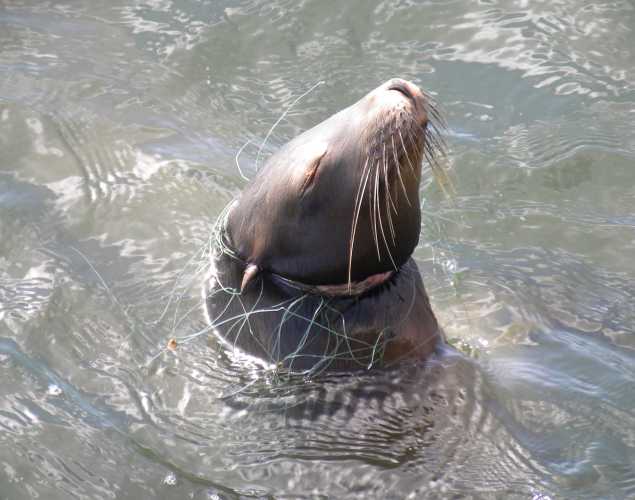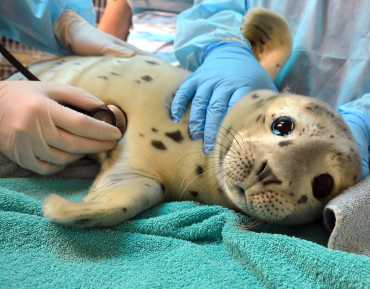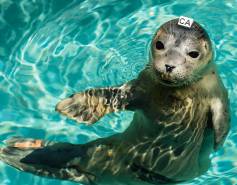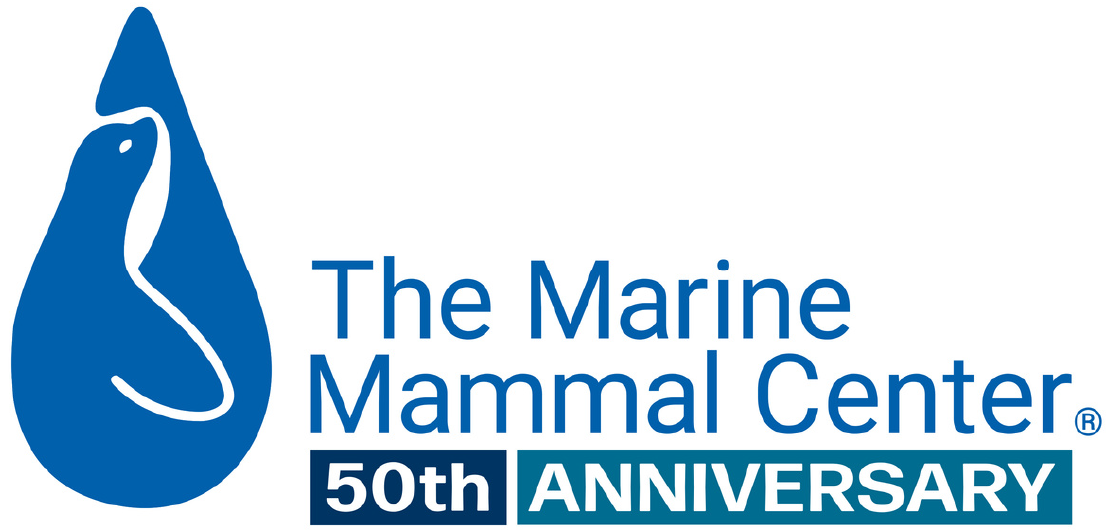
Elusive Entangled Sea Lion O’Neill Is Finally Free
- Telemetry
- Entanglement
Using an innovative new technique, our Special Rescue Operations team saves a sea lion entangled in fishing nets.
ping ... Ping ... PING!
“The louder the ‘pings,’ the closer the animal,” explains Dr. Greg Frankfurter, The Marine Mammal Center’s Koret Foundation Veterinary Intern. The Center’s Special Rescue Operations team listens in anticipation, adjusting their hydrophone (an underwater microphone) as volunteer Doug Ross moves the boat in the direction of the sound.
A small acoustic dart the size of a pencil is drawing the team closer to a California sea lion in need of rescue. The 140-pound juvenile female has monofilament netting wrapped around her head and neck, cutting into her skin and exposing an open wound. The rescue team has just tagged her with the dart so they can follow her movements and attempt a rescue.
The Marine Mammal Center has been trying to rescue this entangled sea lion for more than a year and a half. During that time, our rescue hotline received more than 100 calls about her, including a number of reports from our friends at O’Neill Sea Odyssey—a nonprofit focused on marine science education—thus earning her the name “O’Neill.”
But each time we sent our volunteers out to assess O’Neill’s condition, she had either disappeared or moved to an inaccessible location, such as under the pier at the Santa Cruz Wharf or atop a large buoy in the middle of the harbor.
We made multiple rescue attempts, but O’Neill was able to evade our team every time. Our experts knew they would need an innovative strategy—and the right technology—to successfully rescue and free O’Neill from her entanglement.
The greatest threats to marine mammals are caused by people, but we can also be their greatest champions.
Sign up for email from The Marine Mammal Center to stay updated on how you can be an advocate and champion for marine mammals.
Then on July 21, 2014, O’Neill is spotted again on the buoy in Santa Cruz Harbor. The timing is just right: the team’s specially made acoustic darting equipment has arrived and is ready for action. The “pings” of the acoustic dart will allow them to keep track of O’Neill even if she dives into the water and tries to make another escape.
The Special Rescue Operations team assembles at the harbor and launches a boat toward the buoy. They successfully dart O’Neill and track her movements as she swims through the harbor. They watch her for several hours, but she never hauls out again. She is spotted swimming under the pier, but the team is unable to reach her. They make a plan to meet again the following morning.
On day two of the rescue mission, the team spots O’Neill hauled out on Seal Rock, near Lighthouse Beach. The team approaches slowly by boat, and Dr. Greg Frankfurter successfully administers a light sedative that will slow her down enough to allow the team to use a net to rescue her.
O’Neill dives into the water, once again elusive if not for the pings picked up by the hydrophone. After tracking her to a kelp bed, the team waits for the sedative to take effect. Then, they quietly maneuver the boat closer to her, and Stranding Coordinator Geno DeRango swiftly nets her out of the water.
In less than 30 minutes, O’Neill is on the move again—this time safely contained in a transport crate on her way to The Marine Mammal Center’s hospital in Sausalito.
Once O’Neill is at our hospital and safely anesthetized, Dr. Frankfurter is able to remove the fishing net embedded in the skin around her neck and scrub her wounds, applying a topical antimicrobial medication to help fight infection.
During the exam, Dr. Frankfurter notes the extent of the netting’s damage to O’Neill’s external ear flaps, or pinna. At some point, the fishing line had cut into the pinna, and during the healing process, skin grew over the opening to the ear.
Based on the scarring, X-rays of her skull and her behavior, Dr. Frankfurter suspects O’Neill may have some hearing loss. He compares the situation to that of someone wearing ear muffs all the time. Although O’Neill’s neck wound will heal over time in the salty water, the hearing loss will be a lasting remnant of her human-caused injuries.
After a week of recovery at the Center, O’Neill is deemed ready to return to the wild. On July 29, she’s released off the side of O’Neill Sea Odyssey’s 65-foot catamaran in Santa Cruz Harbor. After diving off the side of the boat, O’Neill disappears into the depths again, finally free of her entanglement.
Now she has a second chance at life.
Yes, I want to save a life!

Yes, I want to save a life!
You’ll be giving sick and injured animals the best possible care at the Center’s state-of-the-art hospital. With your gift today, you are giving a patient a second chance at life in the wild.
See Our Latest News
{"image":"\/Animals\/Patients\/Harbor seals\/2020\/cropped-images\/hs-barnwood-by-bill-hunnewell-c-the-marine-mammal-center-315-0-3299-2577-1607370547.jpg","alt":"harbor seal Barnwood","title":"Last-Minute Gift Guide \u2013 Top Gifts that Give Back to Marine Animals","link_url":"https:\/\/www.marinemammalcenter.org\/news\/last-minute-gift-guide","label":"News Update","date":"2025-12-18 01:00:00"}

Last-Minute Gift Guide – Top Gifts that Give Back to Marine Animals
December 18, 2025
Read More{"image":"\/Animals\/Patients\/Hawaiian monk seals\/2025\/cropped-images\/b-ru72admission-to-ke-kai-ola112125photo-c-the-marine-mammal-center-noaa-permit-24359-0-364-1270-992-1766095407.jpg","alt":"A newborn Hawaiian monk seal pup with a black coat in rehabilitative care.","title":"Newborn Hawaiian Monk Seal Pup Now Receiving Care","link_url":"https:\/\/www.marinemammalcenter.org\/news\/newborn-hawaiian-monk-seal-pup-now-receiving-care","label":"Patient Update","date":"2025-12-18 01:00:00"}

{"image":"\/Animals\/Patients\/Hawaiian monk seals\/2025\/cropped-images\/d-ru28release-exam-at-ke-kai-ola111025photo-by-giancarlo-rulli-c-the-marine-mammal-center-noaa-permit-24359-0-0-1270-992-1764620886.jpg","alt":"","title":"Bird Flu Vaccine Trial Offers Hope for Protecting Hawaiian Monk Seals","link_url":"https:\/\/www.marinemammalcenter.org\/news\/bird-flu-vaccine-trial-may-offer-hope-for-protecting-hawaiian-monk-seals","label":"News Update","date":"2025-12-01 08:13:00"}

Bird Flu Vaccine Trial Offers Hope for Protecting Hawaiian Monk Seals
December 1, 2025
Read More{"image":"\/Animals\/Patients\/Hawaiian monk seals\/2021\/hms-pp08-by-sheila-latta-c-the-marine-mammal-center-noaa-permit-18786.jpg","alt":"Hawaiian monk seal","title":"The New York Times: Inside the Bird-Flu Vaccine Trial for Monk Seals","link_url":"https:\/\/www.marinemammalcenter.org\/news\/the-new-york-times-inside-the-bird-flu-vaccine-trial-for-monk-seals","label":"In the News","date":"2025-12-01 01:00:00"}

The New York Times: Inside the Bird-Flu Vaccine Trial for Monk Seals
December 1, 2025
Read More



